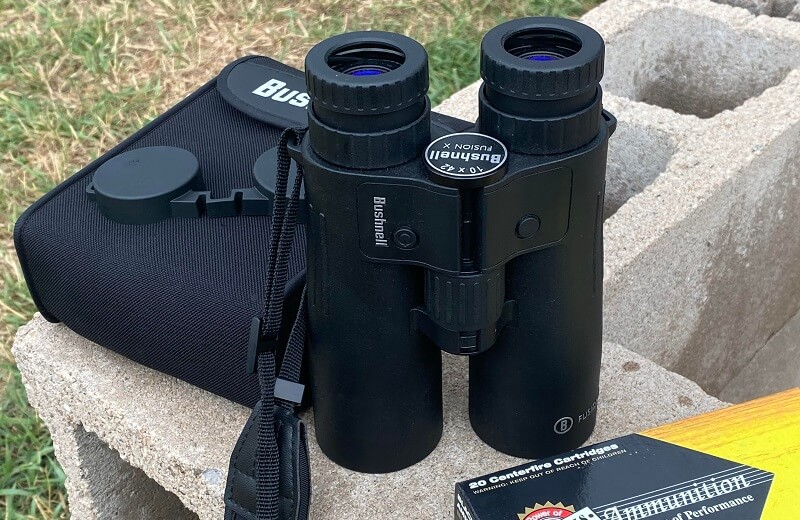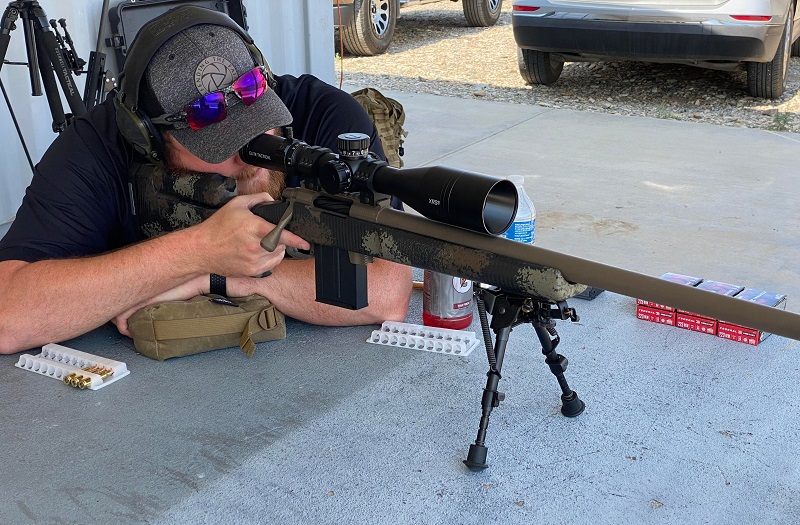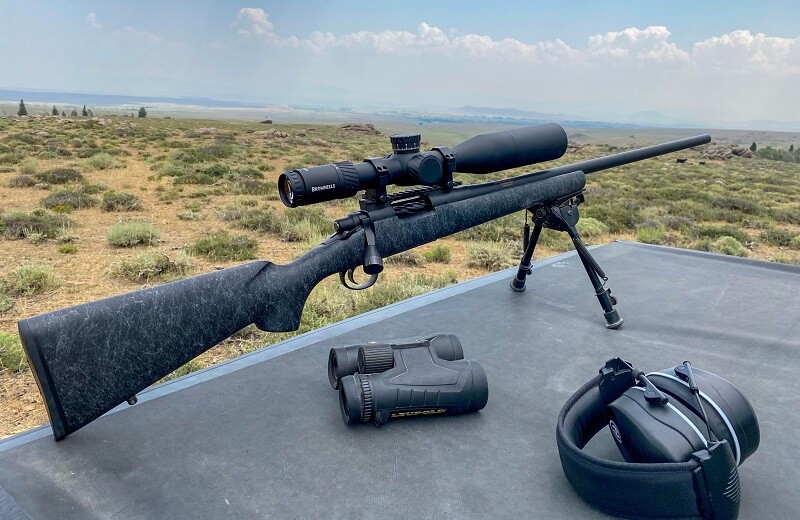Navigate This Post
In 1996, Bushnell introduced an affordable, handheld laser rangefinder to the US market. As I pen this piece that has been twenty-five years. In the next several paragraphs, we will consider some of the changes in our world that can be attributed to the advancement of laser rangefinders and range-finding technology. I’m going to explain what a laser rangefinder is. I’m also going to define long range shooting, and discuss how laser range-finding technology has changed that world entirely.

The Bushnell Fusion X laser rangefinder binoculars calculate distance out to a mile.
What are Laser Rangefinders and how do they Work?
GET OUR FREE WEEKLY NEWSLETTER
The laser or light amplification by stimulated electromagnetic radiation began with a 1917 paper by Albert Einstein on the quantum theory of radiation. Since that time, the laser has been used for a myriad purposes. For our discussion here, a laser rangefinder is a device that uses a laser projection which is also read or picked up by that device. The device then translates the data received into a usable distance; be it Imperial/English yards/miles or Metric meters/kilometers.
Naturally, the original laser rangefinders were relatively large. They were vehicle mounted affairs that required a considerable power source. When I was in the Marine Corps infantry, our tanks were equipped with laser rangefinders. Those lasers were so powerful that the troops were issued protective eyewear to shield them from a negligent lasing which could damage or destroy a person’s vision.
Today’s handheld devices are not so powerful that you could accidentally blind your range partner. But, they are incredibly useful for hunters and shooters. Several companies in the United States offer handheld rangefinder devices and Bushnell is at the forefront. They have been for quite some time now.
Long Range Shooting.
Long range shooting in the United States of America is not a new activity. The Creedmoor Range on Long Island, New York hosted the first International Rifle Match in 1874 where shooters engaged targets out to 1000 yards. The Wimbledon Cup rifle matches also require shooters to hit 1000 yard targets. One of the most famous men to win the Wimbledon Cup at Camp Perry, Ohio, was a man named Lance Corporal Carlos N. Hathcock, USMC. You might know him better as the White Feather.
Despite the century and a half history of long range shooting, only a relatively small number of Americans actually participate in the activity. When it comes to shooting competitions, action shooting events such as USPSA/IPSC, IPDA, Steel Challenge, etc. have been the most popular shooting sports. That situation has been changing over the last ten to fifteen years.
I believe it is a safe assumption to say that more American shooters are engaging in long range or long distance shooting activities than have been in decades or longer. When you consider the Beatle-Mania like popularity of the 6.5 Creedmoor, the 6.5 PRC from Hornady and now the 6mm Creedmoor, it is not hard to divine that Americans want to shoot long distance calibers in their rifles. Don’t believe me? Post a bolt-gun on Instagram. Someone will ask you if it’s 6.5 Creedmoor within the first couple of comments.

Full30’s Josh Brooks engages targets at 1000 yards.
What is Long Distance Shooting?
Before we go any further, I suppose we need to set the bar for what constitutes “long distance shooting”. To be truthful, that term can be rather subjective. If a person has never fired their rifle at a target beyond 100 yards, to them a 500 or even a 300 yard target might seem to be long distance. When we qualified with our M16A2 rifles in Marine Corps Basic Training, we engaged targets out to 500 yards (or meters at Camp Pendleton). To us, we thought we were shooting long distance.
Despite personal feelings or perceptions, a 500 yard target is now mid-range. The technology of rifle barrels, triggers, optics, and of course cartridges make this fact reality now. Going back to our historical examples of the International Rifle Matches and the Wimbledon Cup, 1000 yards would seem to be the benchmark for long distance rifle shooting.
If you are an enthusiastic American shooter with quality gear, what is the key component for long distance shooting? The simple answer is the ability to accurately judge and calculate target distance. Yes, you might have a Known Distance rifle range at your disposal with target berms laid out, but will you always be on that range? What if you were able to accurately calculate target distance anywhere or any place?
Real world application doesn’t happen on a KD-range.
Why Laser Rangefinders Matter.
Enter the laser rangefinder.
With a laser rangefinder in their pack, any skilled shooter who has calculated the dope on his rifle scope can put first-round shots on target. Even if they are not on their home KD range, rangefinders make this possible.
Hunters who would not have risked a long shot on a deer or elk when they had to guess the range can now put them down at distances that heretofore seem out of reach. Competitors are now clearing shooting matches with steel targets spread out from 500 to 1000 yards and farther. How is this possible? Laser rangefinders and skilled marksmanship.
Also, those who simply have access to wide open land can place targets out and get an absolutely accurate distance to them. In the past they would guess or estimate with a pace-count. That is no longer the case. Laser rangefinders have solved that problem within +/- 1 yard of accuracy.
All of the aforementioned are giant leaps forward in the long range shooting game.

Successful long distance hunting opportunities are a result of affordable laser rangefinders.
21st Century Technology: Bushnell Rangefinder
Twenty plus years ago when I used a handheld laser rangefinder for the first time, I was thoroughly impressed. To be able to range a target beyond five hundred yards, it seemed like magic to me. Now, looking back, the rangefinders from the late 90’s and even the early 2000’s seem like antiques. The technology has advanced at a cyclic rate, and there’s no denying the progress.
Recently, I was able to work with two brand new laser rangefinders from Bushnell. The Nitro 1800 monocular, and the Fusion X 10×42 binoculars. The Nitro 1800 is very lightweight and compact, weighing only 5.7 ounces, but it can range up to 2000 yards. The Fusion X binoculars give you the advantage of crystal clear magnification of your target plus the ability to range it beyond a mile. The Nitro 1800 is priced below $400 and the Fusion X is below $700.
Just as we have witnessed with night vision and thermal optic technology, laser rangefinders today are leaps and bounds ahead of units only ten or fifteen years old. The best news is that this technology is affordable to dedicated long range shooters. You no longer have to be a Special Forces operator. You no longer need a tank. Everyone can get their hands on a rangefinder that will measure distances out to a mile. That, ladies and gentlemen, is nothing to sneeze at.
Professor Paul Markel
Latest posts by Professor Paul Markel (see all)
- Tactical Masturbation: Top 3 Stupid Human Tricks - July 8th, 2024
- Blood Trail: Fearless Fiction - June 21st, 2024
- SOTG and SB Tactical Celebrate Brace Ruling - June 20th, 2024
- Shotgun Accessories: Practical and Useful - June 14th, 2024
- Tactical Rifle Tips: Transition Drills - January 5th, 2024






Trackbacks/Pingbacks